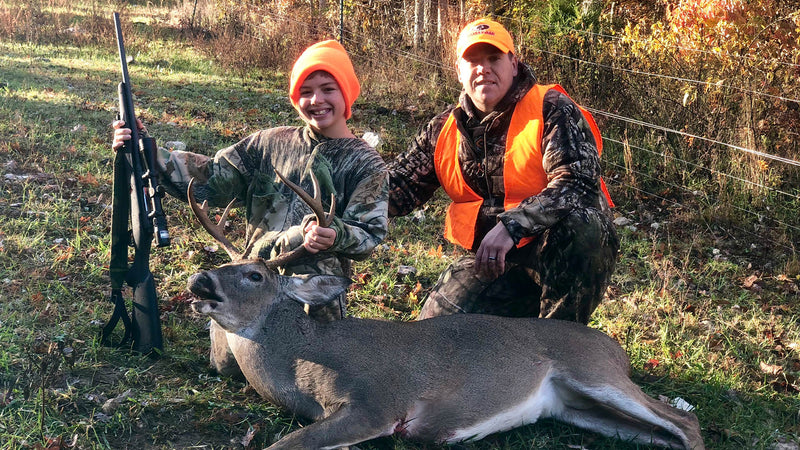After completing three years of being involved with disabled youth turkey hunts, I wondered what my next encounter would be. The three years of turkey hunting were with two different young boys: one who was autistic and one who was blind. In those three years, I learned to appreciate my everyday health and my ability to hunt independently. With myself as the guide and several hard-working volunteers in a local NWTF chapter, both boys harvested their first turkey. Those youth hunts are forever stamped in my brain as being blessed to have been a part of something so special.

Yet, it wasn't until the following fall that I truly was touched and brought back down to earth for a dose of what hunting and life are all about. In the summer of 2015, I was asked if I would be interested in taking another young boy on a deer hunt. The challenge being that this boy had also lost most of his eyesight due to suffering from a brain tumor for the past two years prior. However, with the help of the same NWTF chapter of volunteers, we were able to take the young boy deer hunting with the aid of a rifle that fired when two remotes were pushed at the same time. On the first day of the two-day Missouri youth season, we found ourselves tucked into a ground blind, ready to get the boy his first deer. After an hour of waiting, a mature buck walked in at sixty yards. I immediately tried to get the gun apparatus pointed in the right direction and coach the boy into taking the shot. When the buck stopped broadside, I told the boy to hold in the button on his remote. When I thought I had the crosshairs on the bucks' vitals, I pushed my remote to fire the rifle. Unfortunately, the deer ran off after a clean miss.
After the miss, I was heartbroken. I found myself wondering if I had messed up this special little boy's only chance at a big buck. After talking it over, the young boy insisted that we look for blood. Even though I was 99.9% sure we missed, we did what the young man wanted and went and looked. While holding his hand, my mind kept going back to what wondering what I did wrong and the anger started building. That is when I got my reality check. After twenty minutes of looking for blood, the young boy said to me, "I'm glad we missed that deer." I quickly turned and replied with, “why?” His answer was, "I want to keep hunting with you; I don't want it to be over yet." My heart hurt from embarrassment. I had forgotten the real meaning of the hunting experience. It wasn't about the harvest; it was about making memories with a young boy that was simply happy being outdoors hunting. To this day, that moment has become my testimony on life and hunting. Enjoy the hunt, not the harvest, and be willing to pass it on to the future generation of hunters. Later that morning, the little boy harvested a button buck that came to a grunt call he had been using minutes prior. The enjoyment the boy showed and felt was the same as if we had made the shot on the mature buck earlier.

Taking a child deer hunting is one of the enjoyable experiences made while in the woods. Since 2015 when the young boy got his button buck, I have remembered to enjoy every hunting experience I am on, regardless of the harvest outcome. Whether it is with a young boy or girl on their first hunt, a child who wants to learn more about hunting, or a youth with a disability, I treat them all the same. Have fun and make the experience enjoyable enough that they want to hunt for the rest of their lives.
To ensure a child is having fun and wants to experience more, I have come up with 5 must's when taking a child deer hunting.
1. Keep Them Comfortable
When a child is experiencing a new adventure, they must be comfortable. For anyone who has ever hunted before, they know deer hunting takes patience. If the child does not have a comfortable place to sit or move around, they get bored and want to go home. The first impression is critical. Instead, make sure they have a quiet place to sit and plenty of room. A ground blind is ideal for youth hunting. With a blind, you can get by with more movement, they are able to stretch, and both occupants can sit close and talk throughout the hunt without being seen by approaching wildlife. While hunting from a ground blind, hunters can also use a portable heater when in colder temperatures. By staying warm and comfortable, the new hunter is more likely to have patience and will be ready when it is time to take a shot on a deer.
2. Keep Them Occupied
Although ground blinds keep the hunter warm and comfortable, that does not take away the complete chance of the child becoming bored or tired. To keep a child's attention on having fun and learning about the hunt as time goes on, I bring a small game to play while in the stand to take up time when the action may become slow. A phone works great as well. Also make sure to take plenty of snacks and drinks. Two things will cut a hunt short faster than anything: boredom and hunger. While the blind and the possibility of a small heater will keep you warm and comfortable, access to food and drinks is mandatory. When hunting with kids over the years, I have had the ground inside look like raccoons raiding a trash can. Kids like to snack, keeping their stomachs satisfied, and it gives them something to do while waiting.
3. Participation Throughout The Hunt
To go along with keeping kids occupied and comfortable while deer hunting, the next tip is to keep them involved in the entire hunting experience. We missed the first deer while hunting with the young boy. However, we had a blast keeping him involved the entire morning. Periodically the boy would use his grunt call. He also wanted to spray some scent out the blind window or try to rattle his rattling bag that we had brought along. He always wanted to help be a part of the hunt. It is vital to teach kids about the hunting process instead of pulling the trigger when a deer comes in. Having kids come along while planting food plots, checking game cameras, and using scents and calls during the hunt are great ways to keep them involved.
4. Educational Programs
Including kids throughout the entire hunt is essential, as well as keeping them comfortable throughout the hunt. The next step is to make sure they know what to do when it is time to make the shot. Each year near my hometown, our local NWTF chapter hosts what is called a JAKES Day. During this fun-filled day, kids of all ages learn about firearms safety tips, including how to carry a firearm, and always being aware of what is beyond the shot target. They also get to practice shooting a few rounds of pellets through air rifles. The critical factor is they are
learning how to be safe when handling and shooting a firearm. Plus, they get to participate with all their friends, making it a fun-filled day. Taking kids to events like this is essential to achieve success when in the field hunting. These types of events and also making sure they take their hunter's safety courses are fundamental to them becoming future hunters.
Another great educational technique is to shoot at home with your kids with the weapon they will be using when hunting. Letting them see how the firearms works is vital in making sure they can make a clean, ethical shot while hunting.
5. Celebrate The Harvest
The final key in helping to create a lifetime hunter is to celebrate the harvest. If the child wants to shoot a doe or a spike buck, let them shoot. The adult choosing for them what animal to shoot is a topic that has been argued for many years. I believe that you shoot whatever makes you happy. When a hunter gets excited over a small buck or doe, the same as they do a giant mature buck, that is when you know they enjoy the hunt instead of the competition with their friends over who can shoot the biggest buck.

As with when I hunted with the young boy who had a disability of seeing, he didn't care what he shot; he was simply having fun being in the woods hunting. It is also essential when they do harvest a deer to celebrate and respect the harvest. Make it a big deal, and tell them good job. They will be proud and will want to go year after year.
Taking a child hunting is one of the most rewarding moments of a hunter's life. Whether it is your child, grandchild, a family member or a friends child, introduce them to the outdoors in a positive way. Let them enjoy what thousands of hunters have enjoyed for many years. That is the future of the best sport in the world, hunting.
By: Heath Wood

